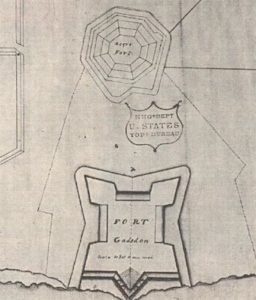
Arial Drawing
*The Negro Fort is celebrated on November 13, 1814. Also known as Fort Gadsden and the Prospect Bluff Historic Site, it is located in Franklin County, Florida.
It was constructed on the Apalachicola River, 6 miles SW of Sumatra, Florida. The British built the site during the War of 1812. After the British evacuated Florida in 1815, they allowed the members of the disbanded Corps of Colonial Marines to occupy it, deliberately leaving their munitions behind. Since the British had not named it, Americans started referring to it as Negro Fort. It was destroyed in a river attack by U.S. forces in 1816.
The Florida panhandle was mostly wilderness before 1814. Its population at the time is unknown, except for isolated reports. Like the rest of Florida, many Native American refugees from the United States merged into a new ethnicity, Seminoles. It provided excellent cover for escaped slaves, who, since they shared a common enemy, got along with the Seminoles fairly well; "over time, a bond developed between escaped Africans and the Seminoles that only increased with time and white pressure for their return." Some became Black Seminoles. There was "reciprocal respect and affection"; the former slaves, who knew English, served as interpreters. This predecessor of the Underground Railroad ran south.
The biggest issue about the area discussed by whites was how to get escaped slaves back or compensation for them and prevent or reduce future escapes. The return of Native Americans was unwanted, and they were soon forcibly removed from Florida as well. As was customary before railroads, settlement took place first along rivers. The name Apalachicola derives from the Apalachee who settled along it before colonial invasions. Settlement at Prospect Bluff by maroons (escaped slaves and their descendants), Seminoles, and a few Europeans are documented at the end of the eighteenth century.
When the British withdrew, they deliberately left all their weapons, hoping the locals would use them to defend themselves from the U.S. attempts to re-enslave them, just as African and Native Americans had assisted the British during the American War of Independence. Some of the Native Americans (Seminoles and Red Stick Creeks) left; they had more options than the escaped slaves because there were Native American communities in Florida they could go to, and no one was looking for them; there was no other community of maroons closer than Angola, Florida. Some remained, along with many of the trained soldiers of the disbanded Corps of Colonial Marines, a British Army regiment of freed slaves. Over the next year, the fort became a growing colony of escaped slaves from Georgia and the Mississippi Territory and became known as the Negro Fort.
It was the center of North America's largest community of free Blacks before the American Civil War. The fort, located as it was near the border, was seen by the U.S. as "a beacon of light to restless and rebellious slaves," "a center of hostility and above all a threat to the security of their slaves," "a direct threat to the slave-holding interests rapidly flocking to the newly opened lands in what is today Mississippi and Alabama." On April 8, 1816, General Andrew Jackson ordered General Gaines to "take care of the situation" because the Fort "ought to be blown up"; it was only fomenting "rapine and plunder," and he should "return the stolen Negros and plunder to their rightful owners." On April 23, he complained to the West Florida military governor, Mauricio de Zúñiga.
On May 26, 1816, the governor told Jackson that he could not act; Jackson then proceeded with his plans to destroy the Fort. On July 27, 1816, American forces entered the opening to the fort's powder magazine, igniting an explosion that was heard more than 100 miles away in Pensacola, and destroyed the fort, killing all but 30 of 300 occupants. It has been called "the single deadliest cannon shot in American history." It was also "the largest battle in history between fugitive slaves and U.S. forces seeking to re-enslave them." The trading post of John Forbes and Company, storekeeper Edward Doyle, was reestablished following the fort's destruction.
Fort Gadsden was built in 1818 within the former walls of the former Negro Fort. The site has been known by several other names, including Fort Blount, African Fort, and Fort Apalachicola. Listed in the National Register of Historic Places, the Prospect Bluff Historic Site is located in the Apalachicola National Forest and is managed by the U.S. Forest Service. The process of memorializing the site began in 1961, when Florida acquired a parcel of 78 acres (32 ha), including the location.
Ownership was later transferred to the federal government and named a National Historic Landmark in 1972. The site contains an explanatory kiosk with artifacts, a picnic area with a pavilion, grills, and restrooms. Four historical markers are Fort Gadsden, British Fort Magazine, Steamship Tragedy, and "Millie Francis." There is no marker for the Negro Fort.